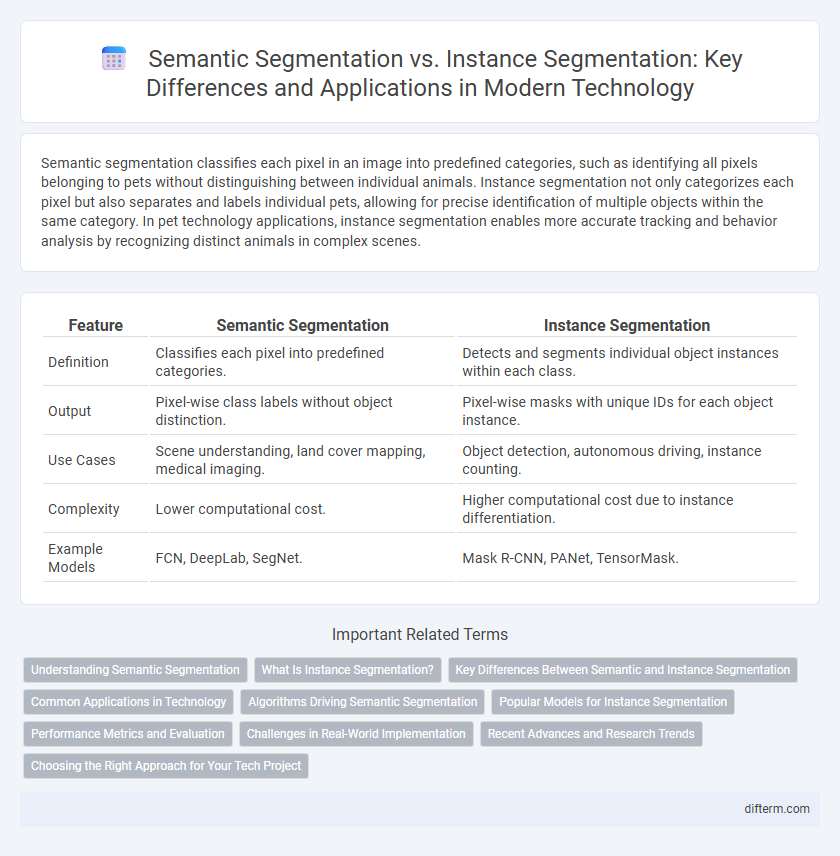Semantic segmentation classifies each pixel in an image into predefined categories, such as identifying all pixels belonging to pets without distinguishing between individual animals. Instance segmentation not only categorizes each pixel but also separates and labels individual pets, allowing for precise identification of multiple objects within the same category. In pet technology applications, instance segmentation enables more accurate tracking and behavior analysis by recognizing distinct animals in complex scenes.
Table of Comparison
| Feature | Semantic Segmentation | Instance Segmentation |
|---|---|---|
| Definition | Classifies each pixel into predefined categories. | Detects and segments individual object instances within each class. |
| Output | Pixel-wise class labels without object distinction. | Pixel-wise masks with unique IDs for each object instance. |
| Use Cases | Scene understanding, land cover mapping, medical imaging. | Object detection, autonomous driving, instance counting. |
| Complexity | Lower computational cost. | Higher computational cost due to instance differentiation. |
| Example Models | FCN, DeepLab, SegNet. | Mask R-CNN, PANet, TensorMask. |
Understanding Semantic Segmentation
Semantic segmentation assigns a class label to every pixel in an image, enabling comprehensive scene understanding by identifying regions such as roads, buildings, and vegetation. It differs from instance segmentation by grouping pixels solely based on class without distinguishing individual object instances. This pixel-level classification is crucial for applications in autonomous driving, medical imaging, and remote sensing where precise environmental context is required.
What Is Instance Segmentation?
Instance segmentation is a computer vision technique that detects and delineates each distinct object within an image at the pixel level, providing a mask that separates individual objects even if they belong to the same category. Unlike semantic segmentation, which classifies pixels by category without distinguishing between separate instances, instance segmentation assigns a unique label to every object instance, enabling precise object recognition and tracking. This technology is crucial for applications like autonomous driving, robotics, and image editing where understanding object boundaries and individuality is essential.
Key Differences Between Semantic and Instance Segmentation
Semantic segmentation classifies each pixel in an image into a category without distinguishing between individual objects, whereas instance segmentation identifies and separates each object instance within a category. Semantic segmentation is used in applications like land cover classification, while instance segmentation is crucial for tasks requiring precise object localization such as autonomous driving and medical imaging. The key difference lies in semantic segmentation's category-level labeling versus instance segmentation's object-level differentiation.
Common Applications in Technology
Semantic segmentation is widely applied in autonomous driving for road scene understanding, enabling vehicles to recognize different objects such as roads, pedestrians, and traffic signs at the pixel level. Instance segmentation enhances security systems by accurately detecting and tracking individual people or objects in surveillance footage, providing detailed object-level differentiation. Both techniques are crucial in medical imaging for disease diagnosis, where semantic segmentation identifies general tissue regions and instance segmentation isolates specific lesions or cells for precise analysis.
Algorithms Driving Semantic Segmentation
Semantic segmentation algorithms primarily rely on convolutional neural networks (CNNs) such as Fully Convolutional Networks (FCNs) and U-Net architectures to classify each pixel into predefined categories. Advanced techniques like DeepLab utilize atrous convolutions and conditional random fields (CRFs) to enhance boundary delineation and spatial accuracy. These algorithms focus on understanding the global context of an image, differentiating semantic classes without distinguishing individual object instances.
Popular Models for Instance Segmentation
Popular models for instance segmentation include Mask R-CNN, which extends Faster R-CNN by adding a branch for predicting object masks, enabling precise pixel-level identification of each instance. Other notable models are YOLACT, known for its real-time performance through a single-shot approach, and SOLOv2, which segments objects by modeling them as categories and locations directly. These models leverage convolutional neural networks and feature pyramid networks to achieve high accuracy in differentiating overlapping objects in complex scenes.
Performance Metrics and Evaluation
Semantic segmentation evaluates pixel-level classification accuracy using metrics such as Intersection over Union (IoU), pixel accuracy, and mean Average Precision (mAP), focusing on how well each pixel is labeled with a class. Instance segmentation extends these metrics by additionally measuring object detection performance, incorporating metrics like Average Precision (AP) per instance and panoptic quality (PQ) to assess both segmentation accuracy and instance differentiation. Evaluation in instance segmentation often requires balancing precision in boundary delineation and the ability to distinguish overlapping objects, making metrics more complex compared to semantic segmentation.
Challenges in Real-World Implementation
Semantic segmentation struggles with differentiating individual object instances in cluttered environments, leading to challenges in precise object boundary detection and overlap handling. Instance segmentation adds complexity by requiring accurate identification and separation of each object, which demands significant computational resources and robust algorithms to manage occlusions and varying object scales. Real-world applications face difficulties from sensor noise, diverse lighting conditions, and real-time processing requirements that hinder reliable and efficient segmentation performance.
Recent Advances and Research Trends
Recent advances in semantic segmentation emphasize deep learning architectures like transformers and attention mechanisms to improve pixel-level classification accuracy in complex scenes. Instance segmentation research trends highlight the integration of mask prediction with object detection frameworks, leveraging convolutional neural networks (CNNs) and graph neural networks (GNNs) to distinguish overlapping objects with higher precision. Emerging approaches combine semi-supervised learning and domain adaptation techniques to enhance segmentation performance across diverse datasets and real-world applications.
Choosing the Right Approach for Your Tech Project
Semantic segmentation classifies each pixel in an image into predefined categories, ideal for tasks requiring scene understanding like autonomous driving or medical imaging. Instance segmentation differentiates individual objects within the same category, providing detailed object-level insights critical for applications such as robotics and augmented reality. Selecting the right approach depends on project goals: choose semantic segmentation for global context analysis and instance segmentation for precise object detection and interaction.
Semantic segmentation vs Instance segmentation Infographic

 difterm.com
difterm.com